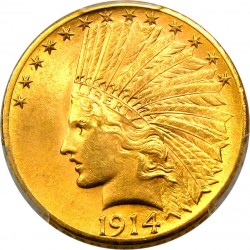

The United States Mint struck Indian Head $10 Gold Coins in 1926 following a hiatus from 1921 through 1925. All 1 million pieces were struck at the Philadelphia mint, and remain common today. In fact, 1926 Indian Head eagles are probably the easiest to obtain across the coin grading spectrum, as they remain relatively easy to find and quite affordable in the uncirculated grades.
Even though this issue is considered common as compared to other dates in the series, these coins are nevertheless still scarce. Famous sculptor Augustus Saint-Gaudens designed the Indian Head $10 Gold Coin. Due to their age (almost 100 years), many Indian Head $10 Gold Coins for sale on the open market may exhibit age related wear and tear. This does make sense, after all, given the fact that these coins were produced to go into circulation. There are, however, Indian Head $10 Gold Coins available in brilliant, uncirculated condition as well that still appear to be brand new.
For coins that are more almost a century old, the condition of the piece is something that is the source of constant wonder. Because these coins have been heavily circulated for decades on end, more are in sub-par condition than are in great condition. For this reason, you will see any prospective buyer take note of any and all imperfections on the faces of a given coin.
For most people, the best way to have a coin’s condition judged is to send the coin away for grading. Knowing that this is an expensive process, we have provided below an outline of the different coin grades as well as their characteristics.
Uncirculated: An Uncirculated coin is one that spent almost no time at all in circulation and did not incur any amount of damage. You will notice that these coins take on the appearance of a brand new coin in that all of the textured surfaces and inscriptions have been preserved. For collectors, these are the best of the best.
Extremely Fine: If a coin is determined to be Extremely Fine, this means that the piece is in great condition, but does show some damage. Under close inspection, you will notice some light scratching and other small signs of damage. These coins are also in great condition and are a great addition to any collection new or old.
Fine: If a coin is determined to be of Fine grade, this means that the coin in question plays host to a good bit of damage. From scratching to chipping and just about anything in between, you will notice these coins have seen better days. For collectors, these are great additions that are also quite affordable.
Good: Good is the lowest grade a coin can receive and is assigned to those pieces that have spent elongated periods of time in circulation. These coins will play host to a whole lot of damage that can vary dramatically from coin to coin.
Giving the 1926 Indian Head $10 Gold Coin a price is no more difficult than assessing its condition. Because collectors are willing to pay top-dollar for a coin in excellent condition, you can see why everyone who owns these coins tries to keep them in the best possible shape. The chart below will help give you a better idea as to what a graded 1926 Indian Head $10 Gold Coin might cost you today.

Indian Head $10 Gold Coin
| DATE | GOOD | FINE | EXTREMELY FINE | UNCIRCULATED |
|---|---|---|---|---|
| 1926 Indian Head $10 Gold Coin | N/A | N/A | $750 | $775 | Source: Red Book |